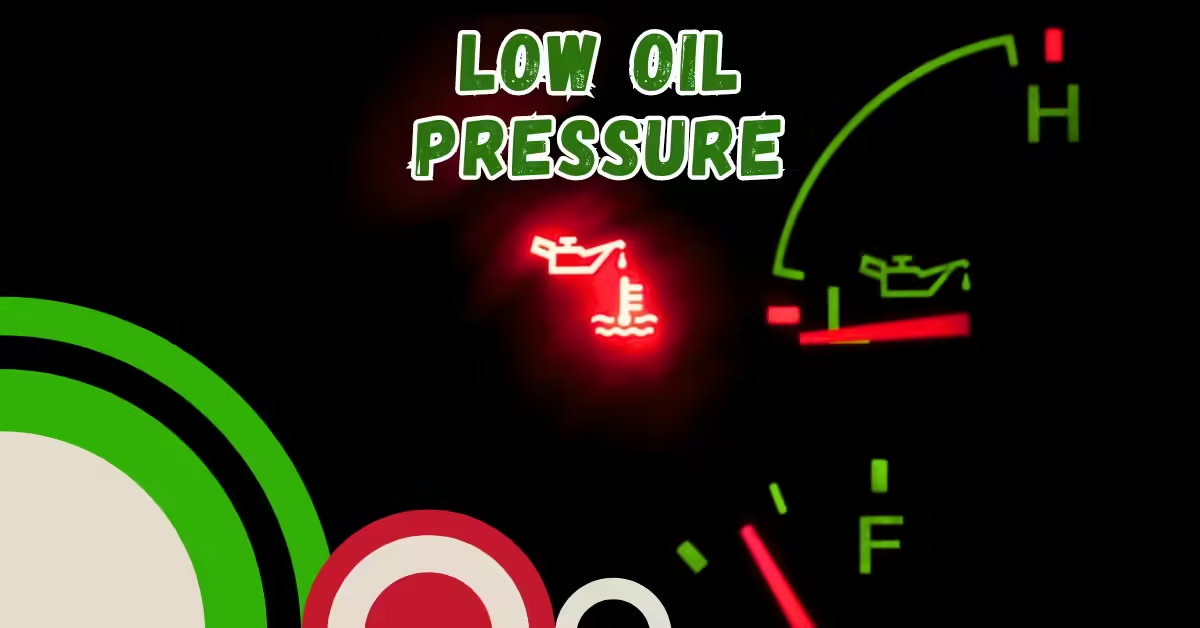Experiencing low oil pressure in your vehicle can be alarming and should never be overlooked.It can lead to severe engine damage if not addressed promptly. Understanding the reasons behind this issue and recognizing the warning signs can help prevent more significant problems later on. In this article, we’ll explore 5 alarming causes of low oil pressure and provide insight into how you can protect your engine from costly repairs.
What is Low Oil Pressure? Understanding the Basics
Having the right amount of oil circulating through your vehicle’s engine is essential for keeping all parts lubricated and preventing friction that could lead to overheating or even failure. When the flow of oil is disrupted or the level is too low, your car’s engine parts may rub together and cause damage.
1. The Role of Oil in Your Engine
Engine oil is responsible for lubricating moving parts, preventing metal-to-metal contact that can cause wear and tear. It also helps in cooling the engine by carrying heat away from critical components. When oil pressure is low, these essential functions are compromised.
2. Why Does Low Oil Pressure Happen?
Oil flow can drop due to various reasons, such as insufficient oil in the system or mechanical issues inside the engine. Regular maintenance and monitoring can prevent these problems before they worsen.
Common Symptoms of Low Oil Pressure: What to Watch Out For
Recognizing the signs of low oil pressure is critical to preventing further damage to your vehicle. Here are some of the most common symptoms you should look out for:
1. Warning Light on Dashboard
The oil pressure warning light is often the first indication of low oil pressure. If this light illuminates on your dashboard, it’s essential to take immediate action and check your oil levels.
2. Engine Overheating
Low oil pressure leads to insufficient lubrication, causing friction between moving parts and generating excessive heat. This can cause your engine to overheat, which can be dangerous if left unchecked.
3. Unusual Engine Noise
Without the right amount of lubrication, metal parts in your engine might begin to knock or grind against each other. This type of noise indicates that the engine is not receiving the protection it needs.
- Reduced Engine Performance
If your car is not performing well, especially during acceleration or idling, this could be another sign of inadequate oil circulation. The engine will struggle to function efficiently if its parts aren’t properly lubricated.
5 Alarming Causes of Low Oil Pressure You Should Never Ignore
There are several reasons why your car might be experiencing low oil pressure. Some of these issues are more severe than others, but all should be addressed as soon as possible to avoid further damage.
1. Low Oil Levels
Not enough oil in the engine is one of the most common reasons for lubrication problems. If the oil levels drop too low, the pump can’t distribute oil effectively throughout the engine. Regular checks and refills can prevent this.
- Worn Engine Bearings
Over time, your engine’s bearings can wear out from friction. When this happens, oil leaks out, and the engine loses lubrication. This can be extremely damaging if left untreated.
3. Faulty Oil Pump
The oil pump is responsible for circulating oil through the engine. If the oil pump is failing or malfunctioning, it won’t be able to maintain adequate pressure, causing low oil pressure throughout the engine. This is a serious issue that often requires a mechanic’s attention.
4. Oil Leaks
Oil leaks can occur for various reasons, such as a damaged gasket, cracked seals, or worn engine components. These leaks can result in a drop in oil levels, leading to low oil pressure and insufficient lubrication.
5. Contaminated or Degraded Oil
Over time, engine oil can become contaminated with debris, dirt, or metal particles. Additionally, oil can degrade due to heat and use, losing its viscosity and effectiveness. Using old or contaminated oil can result in low oil pressure, reducing the oil’s ability to lubricate the engine properly.
How to Fix Low Oil Pressure in Your Vehicle: A Step-by-Step Guide
If you are dealing with these issues, it’s essential to take the right steps to avoid causing further harm to your engine. Here’s what you can do to resolve the issue:
1. Check the Oil Level
The first and simplest step is to check your car’s oil level using the dipstick. If the oil is low, top it off to the recommended level and see if the issue persists.
2. Inspect for Leaks
Next, inspect your engine for any signs of oil leaks. Leaks can usually be found around the oil pan, gaskets, or seals. If you notice oil spots under your car or any visible leaks, it’s important to get the problem fixed immediately.
3. Replace the Oil and Filter
If the oil is old or contaminated, replace the oil and oil filter. Using the proper oil grade for your vehicle is critical to ensuring that your engine operates with the correct oil pressure.
4. Inspect the Oil Pump
If low oil pressure persists after addressing these basic issues, the problem may lie with the oil pump. A faulty oil pump will need to be inspected and replaced by a mechanic.
Is Low Oil Pressure Dangerous? Understanding the Risks for Your Engine
Yes, it can be extremely dangerous for your engine. If left unresolved, low oil pressure can cause serious, irreversible damage to your vehicle’s engine components.
1. Engine Wear and Tear
Without sufficient oil pressure, engine components are not properly lubricated. This leads to increased friction between parts, which accelerates wear and tear. Over time, this can cause parts to degrade, resulting in expensive repairs.
2. Risk of Engine Failure
If the problem continues, your engine may overheat or seize completely. This could leave you with a non-functioning vehicle and require major repairs or replacement.
Top 3 Signs Your Low Oil Pressure Sensor Might Be Failing
Sometimes, you may notice that the oil warning light comes on even when there doesn’t seem to be a problem. This could be due to a faulty sensor.
1. Fluctuating Oil Pressure Reading
If the oil pressure gauge is showing erratic readings that don’t match the condition of your vehicle, it could indicate that the oil pressure sensor is malfunctioning.
2. Oil Pressure Light Stays On
If the oil pressure warning light stays on even after checking the oil level and there are no visible signs of engine issues, the sensor might be at fault.
3. False Alarms
If you’ve experienced several instances where the oil pressure warning light comes on and off without any real change in engine performance, the sensor could be faulty.
How to Prevent Low Oil Pressure in Your Car: Maintenance Tips
The best way to avoid low oil pressure is through regular vehicle maintenance. Here are a few tips to help you maintain healthy oil pressure levels.
1. Regular Oil Changes
Ensure you change your vehicle’s oil and oil filter according to the manufacturer’s recommendations. Regular oil changes prevent oil from degrading and ensure it remains effective at lubricating your engine.
2. Monitor Oil Levels
Regularly check your oil levels using the dipstick and top off as needed. Catching low oil levels early can prevent more serious issues from developing.
3. Address Leaks Immediately
Fix any leaks as soon as you notice them to prevent long-term damage to your engine.
Want a deeper dive into the causes and fixes of low engine oil pressure? Check out our comprehensive guide here to learn more and safeguard your engine from costly repairs.
When to See a Mechanic: Low Oil Pressure Issues You Can’t Fix on Your Own
In some cases, fixing low oil pressure may require professional help. Here are a few situations when it’s best to consult a mechanic.
1. Persistent Low Oil Pressure
If you’ve topped off the oil and replaced the filter, but the warning persists, it’s time to take your car to a mechanic. They will be able to diagnose the problem more accurately.
2. Oil Pump Failure
Replacing an oil pump is a complex process that often requires specialized tools and expertise. If the oil pump is failing, a mechanic will be able to replace it and restore normal oil pressure.
Conclusion: Why Low Oil Pressure Should Never Be Ignored
Ignoring low oil pressure in your vehicle can lead to severe engine damage and costly repairs. By staying vigilant and addressing the common causes of low oil pressure, you can protect your engine and ensure that it runs smoothly for years to come. Regular maintenance, checking oil levels, and staying alert to warning signs are key to keeping your car’s engine healthy.
FAQs About Low Oil Pressure
- What does low oil pressure mean?
Low oil pressure means that there isn’t enough oil flowing through the engine to properly lubricate its components. - Can I drive with low oil pressure?
No, driving with low oil pressure can cause serious damage to your engine and should be addressed immediately. - What causes low oil pressure?
Common causes include low oil levels, worn engine bearings, faulty oil pumps, and oil leaks. - How do I check oil pressure in my car?
You can use an oil pressure gauge or rely on the dashboard oil pressure warning light to monitor oil pressure levels. - How can I prevent low oil pressure?
Regular oil changes, monitoring oil levels, and fixing leaks promptly can help prevent low oil pressure in your vehicle. - How often should I check my oil levels to prevent low oil pressure?
It’s recommended to check your oil levels at least once a month or before long trips to prevent low oil pressure issues. - Can using the wrong oil type cause low oil pressure?
Yes, using the wrong oil type, such as oil with incorrect viscosity, can lead to low oil pressure as it may not flow properly through the engine. - What happens if I ignore low oil pressure for too long?
Ignoring low oil pressure can lead to severe engine damage, including engine seizure, overheating, and premature wear of critical components. - Can a clogged oil filter cause low oil pressure?
Yes, a clogged oil filter can restrict oil flow and result in low oil pressure, as it prevents oil from circulating freely through the engine. - Does cold weather affect oil pressure?
Yes, cold weather can cause oil to thicken, which may temporarily result in low oil pressure until the engine warms up and the oil thins out.

Joseph Bush is a seasoned writer and researcher with over 7 years of experience covering a wide range of general topics, from lifestyle and technology to business and current events. He is dedicated to producing fact-checked, reader-friendly content that informs, engages, and empowers readers.
Throughout his career, Joseph has followed strict editorial guidelines, relied on reputable sources, and ensured every article meets the highest standards of accuracy and clarity. His expertise spans multiple fields, allowing him to explain complex topics in a way that’s easy to understand.
Passionate about continuous learning, Joseph stays updated on industry trends and best practices to deliver trustworthy, well-rounded insights. Readers can rely on his work for its credibility, depth, and real-world relevance.




